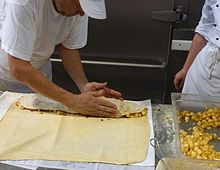Strudel
The menu at the Ritz hotel in Paris in the early 19th century, for example, included 'Rétes Hongrois', for which the strudel flour was ordered from Hungary and the pâtissiers were sent to Pest to learn.The dough is worked vigorously, rested, and then rolled out and stretched by hand very thinly with the help of a clean linen tea towel[10] or kitchen paper.[13] There are also savoury strudels incorporating spinach, cabbage, potato, pumpkin, and sauerkraut,[14] and versions containing meat fillings such as the Lungenstrudel or Fleischstrudel.[20] The 19th-century American writer Alice Lee Moqué recorded an encounter with savoury strudel, ordered mistakenly as a dessert, in her account of her travels through Dalmatia (modern-day Croatia), at the Hotel Petka in Gravosa (Gruz).[21] Observant Hungarian Jews would make the dough with oil and serve them for Simchat Torah and Purim, to match the customary drink imbibed at these celebrations.[24]) In Hungary, rétes, a traditional Hungarian strudel is consumed at Farsang or New Year, because it is believed to bring good luck and a long life.

Strudel (ice)Nut rollStreuselPastryAustrian EmpireFilo pastryHabsburg EmpireAustrian cuisineGerman cuisineCentral European cuisinesprodotto agroalimentare tradizionaleSouth TyrolMillirahmstrudelWienbibliothek im RathausbörekbaklavaloanwordMiddle High GermanwhirlpoolHungarianpâtissierspuff pastryglutenapple strudelquark cheeseTopfensour cherryapricotpoppy seedraisinspinachcabbagesauerkrautcottage cheesesour cherriesapplespoppy seedswalnutssour creamBelle de BoskoopStayman WinesapGravensteinNewtown PippinBramley's SeedlingKarmijn de SonnavilleZabergau ReinetteCalville BlancGranny SmithGlockenapfelJonagoldJonathanNorthern SpyRhode Island GreeningYiddishAshkenazi Jewish cuisineHungarian JewsAlice Lee MoquéSimchat TorahHebrew languagerollmopskanelbullenursery rhymescircle danceshapeshiftingItalian Ministry of Agricultural, Food and Forestry PoliciesWayback MachineOld High GermanSeebold, ElmarThe GuardianJewish cuisineAncient Israelite cuisine1902 kosher meat boycottJewish-American patronage of Chinese restaurantsAshkenaziAmericanEthiopianIsraeliMizrahiBukharanMountain JewishMoroccanSyrianSephardiYemeniteFleishigHechsherKashrutKitniyotKosherKosher by ingredientKosher airline mealKosher for PassoverKosher restaurantKosher-styleMashgiachMilchigPareveShechitaRon Ben-IsraelLaura FrankelIna GartenGil MarksJoan NathanRuth ReichlEyal ShaniMichael SolomonovYotam OttolenghiMolly YehApples and honeyBrisketChallahCharosetDabo koloHanukkah geltMishloach manotPain petriPekalachShowbreadTeiglachOnion rollPletzelPumpernickelRye BreadJachnunKubanehLachooh